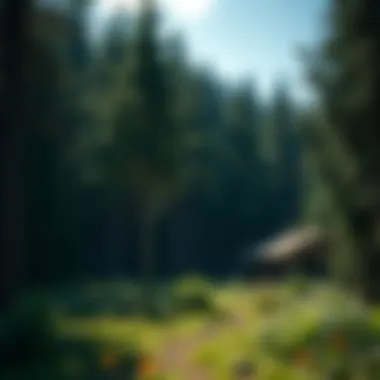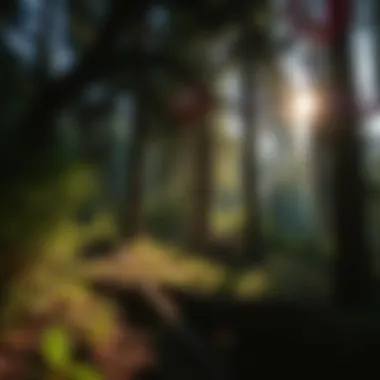Camp Magruder: Historical and Ecological Insights


Intro
Nestled in the lush expanse of the Pacific Northwest, Camp Magruder serves as more than just a retreat; it is a dynamic example of how we can harmonize human activity with nature's rhythms. The essence of this camp lies in its commitment to sustainable practices while also providing an educational hub for those eager to learn about forestry and environmental conservation. This article will unfold the layers of Camp Magruder, weaving together its historical significance, ecological contributions, and its role in promoting sustainable forestry. From the rich tapestry of its origins to the ongoing initiatives that take place today, we will delve into how this location exemplifies thoughtful stewardship of resources.
Understanding Forestry Practices
Forestry has been a crucial element in shaping our landscapes, providing both resources and recreational spaces. At Camp Magruder, the emphasis on sustainable forestry practices is paramount.
Types of Forestry Practices
Within the boundaries of this camp, you’ll find a blend of selective logging, agroforestry, and reforestation practices that align with ecological sustainability. Selective logging focuses on removing only mature trees, allowing younger ones to thrive and ensuring the continuous health of the forest ecosystem. Agroforestry integrates trees and shrubs into agricultural landscapes, while reforestation embodies the camp's commitment to nurturing the ecosystem by planting new trees in deforested areas. These practices not only boost biodiversity but also enhance the resilience of ecosystems against climate change.
Historical Context
To truly appreciate the relevance of forestry practices in Camp Magruder, one must look back at its history. Originally established as a recreational area, it has evolved to incorporate significant conservation efforts that date back decades. As awareness of environmental issues grew in the late 20th century, Camp Magruder stepped up, transforming its recreational focus into one that prioritizes forestry education and sustainable practices. This transition reflects a broader societal shift towards valuing the protection of green spaces amid urban development pressures and climate concerns.
Principles of Woodland Stewardship
Woodland stewardship isn’t just a practice; it’s a philosophy. At Camp Magruder, this philosophy translates into concrete actions and techniques aimed at conserving forest resources while enhancing their longevity.
Conservation Techniques
Conservation techniques employed here are as varied as the landscapes themselves. They include controlled burns that minimize wildfire risks and promote new growth, as well as habitat restoration to support wildlife. This commitment ensures that the forestry practices protect the inherent biodiversity found within the ecosystem.
Managing Forest Resources
Managing forest resources effectively means considering both ecological health and human needs. Camp Magruder focuses on balancing these factors by monitoring the forest's health through regular assessments, fostering partnerships with environmental organizations, and actively engaging in community outreach. By involving local volunteers in stewardship activities, the camp not only maintains its environment but also cultivates a community deeply invested in conservation efforts.
Sustainable Forest Management
Sustainability is a guiding principle at Camp Magruder, and understanding its importance is central to many of the activities conducted there.
Certification Standards
Sustainable forest management often aligns with certification standards established by organizations like the Forest Stewardship Council (FSC). These certifications ensure that forestry operations meet rigorous environmental and social benchmarks. Camp Magruder’s adherence to such standards bolsters its reputation as a model for combining recreation with attentive ecological responsibility.
Economic Benefits of Sustainability
The economic benefits of sustainable practices extend beyond simple resource extraction. They also encompass job creation in conservation roles, ecotourism opportunities that attract visitors, and enhanced property values due to the appeal of well-maintained natural areas. By promoting sustainability, Camp Magruder fosters an environment where economic viability and ecological health flourish hand in hand.
"Sustainability is not just about protecting the earth; it's about ensuring that future generations can thrive alongside it."
As we continue to explore Camp Magruder's multifaceted role in promoting sustainable practices, we uncover not just a physical space but a vital initiative steeped in educational purpose and ecological stewardship. The camp stands as a testament to what can be achieved when we prioritize our forests and commit to working hand-in-hand with nature.
Preface to Camp Magruder
The narrative of Camp Magruder is interwoven with the threads of history, ecology, and community engagement. Understanding this unique place is not just about knowing its physical characteristics but appreciating the legacy it represents. From an ecological seal to a beacon of sustainability, Camp Magruder embodies a multifaceted significance. This section serves as a gateway to exploring an area that serves both as a haven for nature and a hub for community interaction.
Historical Context
Nestled in the stunning landscapes of Oregon, Camp Magruder has a rich historical background that dates back to its establishment in the mid-20th century. Initially conceived as a retreat for youth and families, its purpose has evolved over the years. The camp is steeped in stories of perseverance and growth, showcasing the transformation of recreational spaces that were once only dreams in the eyes of early pioneers.
In the early days, it provided a respite from bustling urban life. The camp quickly became a gathering place for families, offering opportunities for connection with both nature and one another. Such deep roots in community have left an indelible mark on its functioning, allowing it to adapt over time to meet the needs of changing generations.
The relationship between the camp and its visitors reflects broader trends in environmental awareness. As society’s consciousness regarding forestry and conservation emerged, so did a commitment to sustainable practices at Camp Magruder. The camp has thus become not just a retreat, but a focal point for education on ecological responsibility.
Geographical Location
Strategically located along the Oregon coast, Camp Magruder spans a lush 250 acres of pine forests, meadows, and coastal access. Its geographical setting is not only aesthetically pleasing but vital for the ecosystems it supports. The camp lies near the Pacific Ocean, which contributes to its mild climate and diverse flora and fauna.


Access to stunning beaches enhances its appeal; each season brings a different splendor that draws nature enthusiasts and educational groups alike. The blend of forest and coastal environment provides a rich tapestry of habitats critical for various wildlife species.
Visitors can find themselves immersed in the breathtaking scenery, allowing them to reflect on the importance of preserving such natural beauty. The location also facilitates a range of outdoor activities, from hiking to beachcombing, extending the camp's educational offerings beyond structured programs.
As a destination, it is easily accessible yet feels like a world apart—a sanctuary that stands testament to the tradition of nurturing a connection between people and nature. The juxtaposition of its historical grounding with its natural setting speaks volumes about the values Camp Magruder aims to foster, a theme that resonates throughout this exploration.
Ecological Significance of Camp Magruder
Understanding the ecological significance of Camp Magruder is like peeling back an onion—layer by layer, it reveals the unique role this camp plays in the natural world. This section illuminates the intrinsic value of its rich ecosystems, detailing how the biodiversity, habitat variety, and conservation efforts intertwine to form a living tapestry that’s crucial for both environment and community.
Biodiversity Overview
Camp Magruder is a vibrant habitat that showcases a plethora of flora and fauna, blurring the lines between common and rare species. It’s home to numerous ecosystems, each teeming with life. Walking through the forests, one might hear the calls of the Pacific Wren, a small bird that easily gets lost in the chorus of larger species.
The camp's biodiversity can be understood through several key elements:
- Floral Diversity: Over 150 species of native plants grace the camp, including towering conifers like Douglas fir and Western hemlock, alongside understory plants such as salal and Oregon grape. These plants are not only beautiful; they provide essential habitat and food for various wildlife.
- Faunal Diversity: The region's wildlife includes mammals like deer, raccoons, and even shy coyotes. These animals play a vital role in the food chain, supporting the ecological balance.
- Microorganisms: Don't overlook the smaller life forms! From soil bacteria to fungi, these organisms play a crucial role in nutrient cycling and overall ecosystem health. The intricate web of life here is a testament to the camp’s ecological richness and its importance for scientific study and conservation efforts.
"Biodiversity is not something that exists separate from us; it is part of our identity, deeply woven into our cultural heritage."
Habitats and Ecosystems
The various habitats found within Camp Magruder contribute not only to its biodiversity but also to its ecological resilience. Each habitat, with its distinct characteristics, supports different species and ecological functions. Understanding these habitats can provide insights into effective conservation practices.
- Coastal Forests: Dominated by giant evergreens, these forests are the lungs of the ecosystem. The dense canopy provides shade and moisture, fostering a complex understory rich in species diversity.
- Wetlands: Full of life, the wetlands within Camp Magruder are crucial for water filtration and flood control. They serve as breeding grounds for amphibians and habitat for migratory birds. The seasonal changes in wetlands also provide a rich biodiversity hotspot.
- Grasslands: Though they occupy a smaller area, grasslands support a unique community of grasses and wildflowers. These open spaces are essential for pollinators like bees and butterflies, which play a pivotal role in plant reproduction.
In summary, the ecological significance of Camp Magruder cannot be overstated. Its diverse habitats and rich biodiversity reflect the health of the entire ecosystem, providing invaluable services and supporting a myriad of life forms. As stewards of this unique landscape, it becomes imperative to foster and protect these intricate systems for future generations.
Sustainable Practices at Camp Magruder
Sustainable practices at Camp Magruder are not merely a set of guidelines; they represent an intrinsic philosophy guiding its operations and conservation efforts. These practices ensure that the camp nurtures its natural resources and educates visitors on the importance of environmental stewardship. By implementing sustainable techniques, Camp Magruder not only maintains its ecological integrity but also sets a benchmark for similar organizations in the region.
Successful sustainable practices create a framework within which both visitors and locals can engage meaningfully with the environment. The emphasis on conservation and responsible management resonates through various programs and initiatives, positively impacting the community at large. Here are a couple of spotlighted aspects:
- Maintaining Ecological Balance: This is about managing resources in a way that ensures ecosystems remain healthy and vibrant. This balance is pivotal for local wildlife, plant species, and the overall quality of the environment surrounding the camp.
- Educational Outreach: Camp Magruder actively promotes environmental awareness among visitors through workshops, seminars, and hands-on programs that shed light on sustainable practices.
"Sustainability isn’t just a goal; it’s a pathway towards preserving our natural world for generations to come."
Forest Management Techniques
Forest management at Camp Magruder revolves around the idea of conservation with a practical twist. It involves assessing forest health, implementing controlled burns, and selective harvesting.
- Controlled Burns: This technique is employed to reduce excess undergrowth and prevent larger wildfires. The careful execution of these burns rejuvenates the forest ecosystem, promoting new growth while protecting existing flora and fauna.
- Selective Logging: Rather than clear-cutting, the camp utilizes selective logging to remove only certain trees, which helps maintain the overall structure and health of the forest. This approach minimizes damage to the surrounding ecosystem and encourages biodiversity.
- Regular Monitoring: Keeping tabs on forest conditions is crucial. Regular assessments allow for proactive strategies to tackle diseases and invasive species threatening the habitat.
Wildlife Conservation Initiatives
Wildlife conservation initiatives at Camp Magruder reflect a commitment to preserving biodiversity. These initiatives stem from a recognition that each species plays a role in the ecosystem's health.
- Habitat Protection: Initiatives focus on safeguarding natural habitats. This might include the creation of wildlife corridors to allow safe passage for animals between fragmented habitats.
- Community Participation: Engaging the community is vital. Local residents can volunteer for monitoring programs, contributing to wildlife counts or habitat restoration projects, creating a sense of ownership and responsibility for the land.
- Educational Campaigns: Raising awareness about local wildlife and their habitats prepares visitors to become advocates for conservation. Workshops provide information on identifying species, understanding their roles, and recognizing threats they face.
By fostering sustainable practices, Camp Magruder demonstrates how environmental responsibility can harmonize with community engagement and education. The initiatives set forth not only aim to protect the region's natural legacy but also to inspire future generations to continue in these efforts.
Educational Programs Offered
Educational programs at Camp Magruder play a vital role in fostering environmental stewardship and enhancing knowledge among participants. These programs span various topics, catering to diverse age groups and interest levels, thereby enriching the experience of visitors while addressing the broader necessity of ecological literacy. By engaging with these educational offerings, individuals not only gain a deeper understanding of the environment but also feel empowered to make informed decisions regarding sustainability and conservation practices.
Workshops and Training
Workshops at Camp Magruder provide immersive learning experiences tailored to different skill levels. Covering topics such as forest ecology, sustainable agriculture, and wildlife management, these hands-on sessions allow participants to interact directly with the natural world. For instance, an engaging workshop might dive into identifying native plant species, fostering a connection between learners and their local ecosystem.
In addition to content delivery, training programs emphasize practical skills. Participants might learn about tools and techniques for effective conservation practices, including how to implement efficient waste management or establish native gardens. The workshops not only serve to educate but also act as a platform for networking among like-minded individuals passionate about forestry and conservation.


"Education is not the learning of facts, but the training of the mind to think." – Albert Einstein
Skills gained in these workshops have a ripple effect, often extending into communities as participants teach others what they have learned. The hands-on approach builds confidence in applying knowledge practically, leading to positive environmental outcomes long after the workshops conclude.
Youth and Community Engagement
Camp Magruder places a significant emphasis on involving youth and local communities in its educational framework. Programs designed specifically for young people invite them to explore and interact with nature through peer-led initiatives and guided experiences. Activities such as summer camps and field trips offer engaging spaces for youth to explore the wonders of the natural world while gaining insight into the importance of conservation.
Involving the community ensures that educational outreach strategies are culturally relevant and inclusive. By partnering with local schools and organizations, Camp Magruder tailors programs that resonate with those they serve. This collaborative approach not only heightens interest among participants but fosters a sense of community ownership over local environmental issues.
Additionally, volunteer opportunities encourage local residents to become active participants in conservation efforts. Programs that involve habitat restoration or clean-up days help strengthen community bonds and instill a sense of pride in the local environment. When communities come together for a common goal, the benefits extend far beyond the immediate task at hand, paving the way for long-lasting relationships rooted in environmental compassion.
Through these educational initiatives, Camp Magruder not only imparts critical knowledge but also creates ambassadors for the environment within local communities. The impact of these programs can be seen in the enthusiasm participants carry into their personal lives, encouraging a culture of sustainability that resonates beyond the camp itself.
Recreational Opportunities
Recreational activities serve as a fundamental aspect of the experience at Camp Magruder. These opportunities not only promote physical wellness and mental rejuvenation but also foster a deeper connection with the surrounding natural environment. Being engaged in outdoor recreation allows individuals and groups to immerse themselves in nature's beauty while developing a sense of community and stewardship towards the land.
Outdoor Activities Available
At Camp Magruder, outdoor activities are abundant, catering to diverse interests and abilities. The camp offers visitors a chance to participate in:
- Hiking: Several trails wind through the verdant forests, providing stunning views and encounters with local wildlife. These trails range from easy walks suitable for families to challenging routes for the more adventurous.
- Kayaking and Canoeing: With its proximity to water bodies, the camp offers opportunities for kayaking and canoeing. Paddling along the serene waters allows participants to enjoy the tranquility while observing various birds and aquatic life.
- Fishing: Anglers can find peace and sport in the local lakes and rivers. Fishing not only engages visitors but also educates them about sustainable practices in aquatic ecosystems.
- Nature Programs: Guided nature walks and educational programs help participants learn about local flora and fauna. This hands-on education reinforces the camp's mission of environmental stewardship.
- Team-building Activities: Camp Magruder promotes teamwork through structured activities like rope courses and group challenges. Such engagements build skills essential for personal and communal growth.
Each of these activities contributes to a holistic experience at the camp, emphasizing wellness through outdoor participation.
Camping and Retreat Facilities
Camp Magruder provides various accommodations tailored to meet the needs of different groups. The facilities are designed with comfort and functionality in mind, ensuring that guests can unwind after a day filled with adventure.
- Cabins: Cozy cabins equipped with basic amenities offer a rustic yet comfortable retreat, suitable for families or small groups. These cabins are strategically placed to provide privacy while remaining close to the main activity areas.
- Tent Camping Sites: For those who prefer a back-to-nature experience, the camp provides tent sites that allow for a genuine camping experience. Each site is designed to blend into the landscape, ensuring minimal environmental disturbance.
- Meeting Spaces: Facilities that accommodate workshops, group meetings, and retreats are available. These spaces come with necessary equipment, promoting productive gatherings while surrounded by nature's bounty.
- Amenities: Additional amenities such as bathrooms, showers, and communal kitchens are provided to enhance the camping experience. Clean and well-maintained facilities help ensure that all visitors feel welcome and cared for.
Overall, the recreational offerings at Camp Magruder enrich the experience for visitors while emphasizing the need for environmental preservation and personal growth. As guests explore the numerous opportunities, they often leave with newfound appreciation for nature and the importance of caring for it.
"Recreation is not just a leisure activity; it's a chance to connect deeply with nature and reflect on our role as stewards of the earth."
For more details about recreational opportunities and facilities, you can explore the Camp Magruder website or visit resources like Wikipedia for further reading about camping and outdoor activities.
Community Involvement and Partnerships
Community involvement and partnerships at Camp Magruder serve as the backbone of its ongoing development and sustainability. Engaging local residents, organizations, and volunteers not only enriches the camp's programs but also fosters a sense of ownership and responsibility among stakeholders. This collaborative spirit plays a crucial role in ensuring ecological preservation and enhancing the overall experience for visitors.
Local Collaborations
Local collaborations are pivotal for Camp Magruder. By forming alliances with nearby schools, conservation groups, and civic organizations, Camp Magruder amplifies its outreach while creating shared goals in environmental stewardship. These partnerships can come with various benefits:
- Resource Sharing: Collaborating with local entities enhances resource availability, allowing for joint projects that might be too costly or complex for the camp alone.
- Community Engagement: When local groups get involved, it fosters a greater sense of community. Residents can connect to Camp Magruder on a personal level, turning into advocates and volunteers, which helps in creating a steady stream of support.
- Educational Synergy: Through partnerships with educational institutions, Camp Magruder can offer programs that align with school curriculums—promoting environmental education that benefits both students and the camp itself.
One interesting example includes a local school district that partners with Camp Magruder for field trips focused on environmental science. Students not only learn in the field but also contribute by assisting in local conservation projects, such as planting native tree species.
Volunteer Programs
Volunteer programs at Camp Magruder have a two-fold impact: they strengthen community ties and enhance the natural environment. Volunteers are the lifeblood of many maintenance and conservation efforts. These programs often attract individuals from various backgrounds, each bringing unique skills and perspectives that further enrich Camp Magruder's initiatives.
- Hands-On Experience: Volunteering provides community members with a hands-on experience in ecological conservation, fostering deeper connections to the land and its health.
- Skill Development: Participants can acquire valuable skills in forestry management, habitat restoration, and community organization, which can be beneficial both personally and professionally.
- Event Support: Volunteers often play key roles during community events, such as Earth Day celebrations or seasonal festivals, helping to coordinate activities that promote environmental awareness.
"Volunteering at Camp Magruder taught me the importance of community and conservation. I’ve met amazing people and have a newfound appreciation for our local ecosystems."
- A seasoned Camp Magruder Volunteer
Programs like the annual 'Camp Cleanup Day' have seen dozens of volunteers come together to work on campsite maintenance and habitat improvements. This effort not only keeps the camp in shape but also helps instill a sense of pride among volunteers.


In summary, community involvement and partnerships are not just beneficial but essential for the continued success of Camp Magruder. By nurturing local relationships and encouraging volunteer participation, Camp Magruder paves the way for a sustainable future while bridging connections between nature and community.
Challenges Facing Camp Magruder
Camp Magruder, while boasting a rich history and a profound ecological significance, faces numerous challenges that threaten its sustainability and vitality. These challenges are critical not only for the camp itself but also for the broader community and environment it serves. This section will delve into two primary concerns: environmental threats and funding limitations. Together, these issues underscore the importance of vigilant stewardship, strategic planning, and community involvement to secure a sustainable future for Camp Magruder.
Environmental Threats
Environmental threats to Camp Magruder arise from a variety of sources, which, if not addressed, could disrupt its unique ecosystems.
Some potent threats include:
- Climate Change: Fluctuations in temperature and precipitation directly influence the forest composition and wildlife habitat. These changes can lead to the shifting of species distributions and the potential extinction of vulnerable species.
- Invasive Species: Non-native plants and animals encroach upon Camp Magruder, competing with native species for resources. For instance, the spread of species like Japanese knotweed or common buckthorn can drastically alter the habitat's ecological balance.
- Pollution: Nearby urban areas increase the risk of pollution, whether it's from runoff containing chemicals or debris. The impacts of such pollution can extend to both flora and fauna found in the vicinity, jeopardizing the health of ecosystems.
In light of these threats, proactive measures such as habitat restoration and monitoring programs are paramount. Camp Magruder stands at a crucial intersection where local action can have far-reaching positive effects on both the camp's resilience and the surrounding ecology.
A holistic approach addressing these environmental issues not only reinforces Camp Magruder but also serves as a model for similar initiatives elsewhere.
Funding and Resource Limitations
While the ecological importance of Camp Magruder is undisputed, securing adequate funding and resources presents its own set of challenges. Budget constraints hinder both day-to-day operations and long-term initiatives. Key points to consider include:
- Grants and Donations: Reliance on inconsistent sources of funding means that project planning often becomes a gamble. Nonprofit organizations and local businesses can provide some support, but there’s always uncertainty involved in fundraising.
- Budget Allocation: Limited resources force difficult choices regarding which programs to fund. As more pressing challenges arise—like managing environmental threats—those educational programs that foster community engagement may take a back seat.
- Human Resources: Operating with a limited number of staff can lead to burnout and lower efficiency in program delivery. Volunteers play a vital role, yet without proper training and support, their contributions may not reach their full potential.
Navigating the complexities of funding is essential for Camp Magruder to thrive. Investing in diverse funding avenues, including partnerships with local governments, businesses, and environmental organizations, may help alleviate some of the pressures that currently challenge the camp.
The importance of community support cannot be stressed enough; fostering a sense of ownership and responsibility among locals might inspire long-term commitment to preserving Camp Magruder for generations to come.
Future Prospects for Camp Magruder
As we look forward, understanding the future prospects for Camp Magruder becomes paramount. This not only concerns the camp's ability to adapt and thrive in a changing environment but also its position as a center for conservation and community engagement. The evolving landscape of ecological stewardship, driven by both local and global circumstances, plays a significant role in shaping the path ahead.
Vision for Development
The vision for development at Camp Magruder rests on a few key pillars: enhanced educational programs, improved facilities, and increased community involvement. Educating visitors about local ecosystems can forge a deeper connection between people and nature. Programs that blend theory with hands-on experience foster a sense of environmental responsibility and stewardship.
Moreover, improving facilities is not just about adding comforts but ensuring that the camp can support diverse activities while minimizing its ecological footprint. For instance, incorporating eco-friendly building materials and energy-efficient systems in the construction of new facilities can serve as a model for sustainable development.
Equally important is strengthening partnerships with local organizations. Collaborations can help expand outreach and funding opportunities, making the camp more robust and widely recognized. Engaging local communities in the decision-making process encourages ownership and boosts participation, thus ensuring that the camp evolves with its stakeholders’ needs closely in mind.
"Development is not just a goal, but a continuous journey where community input is key to success."
Long-term Conservation Goals
Long-term conservation goals at Camp Magruder focus on preserving its unique biodiversity and ensuring sustainable use of its resources. The commitment to restoring habitats that may have been impacted by human activity plays a significant role here. By implementing reforestation initiatives and habitat restoration projects, the camp can enhance its ecological integrity.
Another aspect of long-term goals is the integration of adaptive management strategies. This approach emphasizes monitoring ecosystems continually and adjusting practices based on observed changes. It’s essential for future resilience against climate variability and other environmental threats.
Moreover, education about conservation practices, targeted not just towards visitors but also the local community, creates a culture of sustainability that propagates beyond the camp. Workshops and events highlighting the importance of preserving natural spaces can lead to a heightened awareness and collective action.
Closure
In summary, Camp Magruder's future prospects paint a bright picture, characterized by thoughtful development and a deep commitment to conservation. Balancing the need for modernization with the essential goal of ecological preservation is not merely aspirational but essential for the longevity of both the camp and the surrounding environment. The upcoming years will undoubtedly present challenges, yet with a clear and inclusive vision, Camp Magruder can continue to thrive as a beacon of sustainable practices and community engagement.
Closure
In wrapping up this comprehensive overview of Camp Magruder, it is essential to recognize the multifaceted significance of this site. Serving as both a historical repository and a beacon of ecological integrity, Camp Magruder encapsulates the essence of environmental stewardship and education. Understanding its role in forestry and conservation allows for a deeper appreciation not just of the park, but of the broader implications for natural spaces everywhere.
Summary of Key Insights
- Historical Significance: Camp Magruder isn't merely a recreational retreat. It's a locus of history that connects visitors to the vital narratives of the region. The stories of the land speak to traditions of both local communities and the natural world.
- Ecological Importance: As we detailed earlier, the biodiversity at Camp Magruder contributes significantly to its ecological stability. Various species thrive here, showcasing nature's complex interdependencies. Preserving this delicate web is crucial for environmental health.
- Sustainable Practices: The initiatives undertaken at Camp Magruder set a benchmark for other areas. From innovative forest management techniques to practical wildlife conservation efforts, the methodologies employed here offer valuable insights into sustainability in practice.
- Educational Engagement: Programs aimed at both youth and the broader community highlight the necessity of fostering a love for nature and the knowledge to protect it. Education at Camp Magruder does not stop at the gates; it resonates within the community long after visits have concluded.
This summary broadly captures the salient points discussed throughout the article. It is these collective insights that not only underline the significance of Camp Magruder but also reinforce the importance of integrating such sites into our conservation ethos.
Call to Action for Preservation
The time is ripe for action; the preservation of Camp Magruder and similar natural spaces is imperative. Here are several steps we, as individuals and professionals, can consider:
- Advocacy: Building awareness around the importance of community support for preservation efforts can stimulate local and state engagement. Participation in forums or social media groups dedicated to environmental advocacy can amplify the message. Websites like reddit.com often have discussions surrounding such initiatives.
- Volunteering: Direct involvement through hands-on work with organizations that maintain or promote Camp Magruder can make a tangible difference. Opportunities might include tree planting, habitat restoration, or educational outreach in local schools.
- Funding Support: Contributing financially to organizations focused on conservation ensures that they can sustain their operations and expand their reach. Regular financial contributions can significantly enhance their capabilities to protect such valuable ecosystems.
- Continuous Education: Engaging with resources on environmental issues, whether through academic institutions or online platforms, helps reinforce knowledge. For factual information on ecological strategies, consider resources like Britannica.







